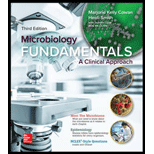
Concept explainers
Which of the following microbes have evolved an intracellular life style?
- a. Bacillus anthracis
- b. Coxiella burnetii
- c. MRSA
- d. two of these
Introduction:
Bacteria are defined as small, microscopic, prokaryotic and unicellular organisms that are not seen by naked eyes. They are found everywhere in nature and hence, are called ubiquities.
Answer to Problem 1Q
Correct answer:
The microbes such as Coxiella burnetii have evolved an intracellular life style. Therefore, option (b) is correct.
Option (b) is given as “Coxiella burnetii”.
Explanation of Solution
Justify reason for the correct statement:
The bacteria Coxiella burnetii is an obligate intracellular pathogen which has evolved and able to survive in harsh conditions inside the intracellular compartments of cells called as phagolysosome. Inside it, the Coxiella phagosome is further developed into large and spacious parasitophorous vacuole. This parasitophorous vacuole has all characteristics of lysosome such as acidic pH, acid hydrolase enzyme and cationic peptides. It provides a defense against host invaders.
Hence, option (b) is correct.
Justify reasons for the incorrect statements:
Option (a) is given as “Bacillus anthracis”.
The life cycle of Bacillus anthracis involves two alternate phages such as vegetative and endospores on the basis of availability of nutrients. Hence, it is a wrong answer.
Option (c) is given as “MRSA”.
It is denoted as methicilin-resistant Staphylococcus aureus and forms colonies for division. Hence, it is a wrong answer.
Option (d) is given as “two of these”.
Coxiella burnetii have evolved to follow intracellular life style. Hence, it is a wrong answer.
Hence, options (a), (c), and (d) are incorrect.
The bacterium Coxiella burnetii is an obligate intracellular pathogen which has evolved and able to survive in harsh conditions inside the intracellular compartments of cells called as phagolysosome.
Want to see more full solutions like this?
Chapter 18 Solutions
Microbiology Fundamentals: A Clinical Approach
- What is the structure and function of Eukaryotic cells, including their organelles? How are Eukaryotic cells different than Prokaryotic cells, in terms of evolution which form of the cell might have came first? How do Eukaryotic cells become malignant (cancerous)?arrow_forwardWhat are the roles of DNA and proteins inside of the cell? What are the building blocks or molecular components of the DNA and proteins? How are proteins produced within the cell? What connection is there between DNA, proteins, and the cell cycle? What is the relationship between DNA, proteins, and Cancer?arrow_forwardWhy cells go through various types of cell division and how eukaryotic cells control cell growth through the cell cycle control system?arrow_forward
- In one paragraph show how atoms and they're structure are related to the structure of dna and proteins. Talk about what atoms are. what they're made of, why chemical bonding is important to DNA?arrow_forwardWhat are the structure and properties of atoms and chemical bonds (especially how they relate to DNA and proteins).arrow_forwardThe Sentinel Cell: Nature’s Answer to Cancer?arrow_forward
- Molecular Biology Question You are working to characterize a novel protein in mice. Analysis shows that high levels of the primary transcript that codes for this protein are found in tissue from the brain, muscle, liver, and pancreas. However, an antibody that recognizes the C-terminal portion of the protein indicates that the protein is present in brain, muscle, and liver, but not in the pancreas. What is the most likely explanation for this result?arrow_forwardMolecular Biology Explain/discuss how “slow stop” and “quick/fast stop” mutants wereused to identify different protein involved in DNA replication in E. coli.arrow_forwardMolecular Biology Question A gene that codes for a protein was removed from a eukaryotic cell and inserted into a prokaryotic cell. Although the gene was successfully transcribed and translated, it produced a different protein than it produced in the eukaryotic cell. What is the most likely explanation?arrow_forward
 Comprehensive Medical Assisting: Administrative a...NursingISBN:9781305964792Author:Wilburta Q. Lindh, Carol D. Tamparo, Barbara M. Dahl, Julie Morris, Cindy CorreaPublisher:Cengage Learning
Comprehensive Medical Assisting: Administrative a...NursingISBN:9781305964792Author:Wilburta Q. Lindh, Carol D. Tamparo, Barbara M. Dahl, Julie Morris, Cindy CorreaPublisher:Cengage Learning Medical Terminology for Health Professions, Spira...Health & NutritionISBN:9781305634350Author:Ann Ehrlich, Carol L. Schroeder, Laura Ehrlich, Katrina A. SchroederPublisher:Cengage Learning
Medical Terminology for Health Professions, Spira...Health & NutritionISBN:9781305634350Author:Ann Ehrlich, Carol L. Schroeder, Laura Ehrlich, Katrina A. SchroederPublisher:Cengage Learning- Basic Clinical Lab Competencies for Respiratory C...NursingISBN:9781285244662Author:WhitePublisher:Cengage






